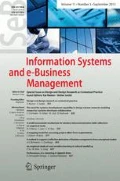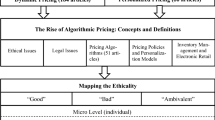Abstract
There is disagreement in the auction literature on the question of whether dynamic Buy-It-Now (BIN) prices can increase the efficiency of online auctions, compared to static BIN price auctions. In a previous paper (Vragov et al. 2010), we reported experimental evidence that suggested, contrary to the current theoretical auction literature, that dynamic BIN pricing is indeed economically more efficient. The current paper presents a replication study of this research that interestingly fails to reproduce the earlier findings. It is based on the same general experimental design, but modifying the implementation of the specific trading institution by using a linearly declining BIN price (Online Linear Dutch Auction—OLDA) rather than the discrete one-time price change (Online One-time BIN-price Change Auction—OOBCA) that was used in the previous study. OLDA is more dynamic in nature than OOBCA, yet OOBCA outperforms a generalized static online auction design in the laboratory while the OLDA does not. We explain these different results, and thus resolve the ostensible contradiction between the two sets of experiments, by concluding that the specific implementation of the trading institution (i.e., the dynamic BIN pricing mechanism) has a significant effect on the overall market efficiency. In other words, our research finds that the efficiency of dynamic buyout price auctions is institution-dependent. This has important theoretical implications as most formal auction models assume that the auction outcome is institution-free. We also discuss some practical implications of our findings.




Similar content being viewed by others
Notes
However, in a few categories of eBay items, the BIN option may continue to be available after the first bid for a limited time (http://pages.ebay.com/help/sell/fixed-price.html).
Replication studies are are more than the mere repetition of previous experiment; they involve an important modification of the original design that allows the researcher to test the limits of generalizability of findings and the discovery of theoretical boundary conditions (cf Guala 2005, pp. 13–15).
Undergraduate students have traditionally been used in experimental economics as the initial subject pool because of many practical considerations. Findings might or might not differ when the subject pool changes, but there have been indications of fairly strong consistencies in terms of findings even if the subject pool changes, for example, in experiments studying the properties of and behavior under continuous double auctions (see Smith 2003).
In OLDA, once the auction starts, the system automatically updates the BIN price every second with the rate of change chosen by the seller in the beginning of the auction. Thus changing the price is costless for the sellers.
For example if a seller with a time cost of $0.05 per second chose a BIN of $60 and that BIN was accepted after one second by a buyer then the seller will earn $60-0.05 = $59.95 for this round. At the same time if this buyer’s value was $84 and his time cost was $0.04 per second, then the buyer will earn $84-60-0.04 = $23.96 for this round.
References
Anandalingam G, Day RW, Raghavan S (2005) The landscape of electronic market design. Manag Sci 51(3):316–327
Angst CM, Agarwal R, Kuruzovich J (2008) Bid or buy? Individual shopping traits as predictors of strategic exit in online auctions. Int J Electron Commer 13(1):59
Ariely D, Simonson I (2003) Buying, bidding, playing, or competing: value assessment and decision dynamics in online auctions. J Consum Psychol 13(1&2):113–123
Caldentey R, Vulcano G (2007) Online auction and list price revenue management. Manag Sci 53(5):795–813
Durham Y, Roelofs M, Standifird S (2004) eBay’s buy-it-now function: who, when and how? Top Econ Policy Anal 4(1):1316
Gallien J, Gupta S (2007) Temporary and permanent buyout prices in online auctions. Manag Sci 53(5):814–833
Guala F (2005) The methodology of experimental economics. Cambridge University Press, New York
Kagel JH (1997) Auctions: a survey of experimental research. In: Kagel JH, Roth AE (eds) The handbook of experimental economics. Princeton University Press, Princeton, pp 501–586
Mann HB, Whitney DR (1947) On a test of whether one of two random variables is stochastically larger than the other. Ann Math Stat 18(1):50–60
Mathews T (2004) The impact of discounting on an auction with a buyout option: a theoretical analysis motivated by eBay’s buy-it-now feature. J Econ (Zeitschrift fur Nationalokonomie) 81(1):25–52
Onur I, Tomak K (2003) Buy-it-now or snipe on eBay? In: Proceedings of the twenty-fourth international conference on information systems (ICIS-03). IEEE Computer Society Press, Seattle, pp 841–845
Parsons S, Marcinkiewicz M, Niu J, Phelps S (2006) Everything you wanted to know about double-auctions, but were afraid to (bid or) ask, working paper. Department of Computer and Information Sciences, Brooklyn College, City University of New York
Plott C (2001) Equilibrium, equilibration, information and multiple markets: from basic science to institutional design, paper presented at the nobel symposium, behavioral and experimental economics, Stockholm
Schwartz RA, Francioni R (2004) Equity markets in actions: the fundamentals of liquidity, market structure and trading. Wiley, Hoboken
Smith VL (1962) An experimental study of competitive market behavior. J Political Econ 20(2):111–137
Smith VL (1976) Experimental economics: induced value theory. Am Econ Rev 66(2), Papers and proceedings of the eighty-eighth annual meeting of the American economic association, pp 274–279
Smith VL (2003) Constructivist and ecological rationality in economics. Am Econ Rev 93(3):465–508
Vragov R (2003) Why is eBay the king of internet auctions? An institutional analysis perspective. e-Ser J 3(3):5–28
Vragov R (2010) Operational efficiency of decentralized internet auction mechanisms. E-Commer Res Appl 9(2):111–125
Vragov R, Shang D, Lang K (2010) Online auctions with buy-it-now pricing: a practical design model and experimental evaluation. Int J Electron Commer 14(4):39–67
Vulkan N (2003) The economics of e-commerce: a strategic guide to understanding and designing the online marketplace. Princeton University Press, Princeton
Wang Sh, Jank W, Shmueli G, Smith P (2006) Modeling price dynamics in eBay auctions using principal differential analysis, Robert H. Smith school research paper, no. RHS-06-052
Wenyan H, Bolivar A (2008) On-line auction efficiency: a survey of eBay auctions. In: Proceedings of WWW2008 conference, Beijing, China, pp 925–934
Whinston A, Gopal R, Tung Y (2007) Efficiency considerations in online auction markets. J Organ Comput Electron Commer 17(1):311–328
Yoo B, Ho K, Tam K (2006) The impact of information in electronic auctions: an analysis of buy-it-now auctions. In: Proceedings of 2006 Hawaii international conference on systems sciences, Kona, Hawaii, pp 167–174
Zhang H, Yin F, Hsu V (2007) The impact of the buy-it-now option on online auctions: an empirical investigation. In: Proceedings of the 6th international workshop on e-business (Web 2007), Montreal, Canada
Author information
Authors and Affiliations
Corresponding author
Rights and permissions
About this article
Cite this article
Vragov, R., Shang, R.D. & Lang, K.R. Institutional dependencies in dynamic buyout price models for online auctions. Inf Syst E-Bus Manage 10, 351–366 (2012). https://doi.org/10.1007/s10257-011-0168-2
Received:
Revised:
Accepted:
Published:
Issue Date:
DOI: https://doi.org/10.1007/s10257-011-0168-2




